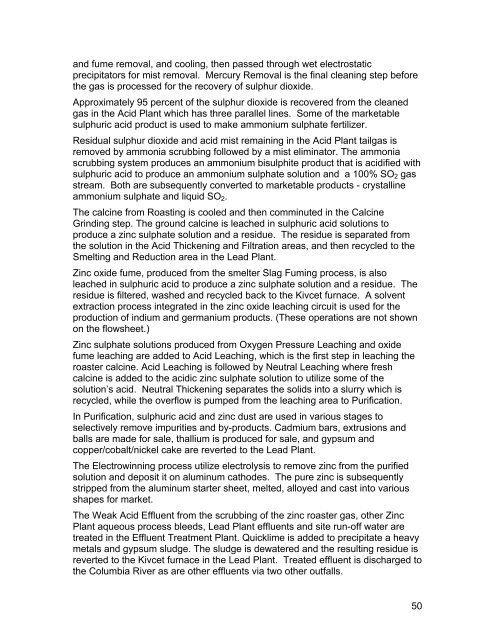(MERAF) for the Base Metals Smelting Sector - CCME
(MERAF) for the Base Metals Smelting Sector - CCME
(MERAF) for the Base Metals Smelting Sector - CCME
You also want an ePaper? Increase the reach of your titles
YUMPU automatically turns print PDFs into web optimized ePapers that Google loves.
and fume removal, and cooling, <strong>the</strong>n passed through wet electrostatic<br />
precipitators <strong>for</strong> mist removal. Mercury Removal is <strong>the</strong> final cleaning step be<strong>for</strong>e<br />
<strong>the</strong> gas is processed <strong>for</strong> <strong>the</strong> recovery of sulphur dioxide.<br />
Approximately 95 percent of <strong>the</strong> sulphur dioxide is recovered from <strong>the</strong> cleaned<br />
gas in <strong>the</strong> Acid Plant which has three parallel lines. Some of <strong>the</strong> marketable<br />
sulphuric acid product is used to make ammonium sulphate fertilizer.<br />
Residual sulphur dioxide and acid mist remaining in <strong>the</strong> Acid Plant tailgas is<br />
removed by ammonia scrubbing followed by a mist eliminator. The ammonia<br />
scrubbing system produces an ammonium bisulphite product that is acidified with<br />
sulphuric acid to produce an ammonium sulphate solution and a 100% SO 2 gas<br />
stream. Both are subsequently converted to marketable products - crystalline<br />
ammonium sulphate and liquid SO 2 .<br />
The calcine from Roasting is cooled and <strong>the</strong>n comminuted in <strong>the</strong> Calcine<br />
Grinding step. The ground calcine is leached in sulphuric acid solutions to<br />
produce a zinc sulphate solution and a residue. The residue is separated from<br />
<strong>the</strong> solution in <strong>the</strong> Acid Thickening and Filtration areas, and <strong>the</strong>n recycled to <strong>the</strong><br />
<strong>Smelting</strong> and Reduction area in <strong>the</strong> Lead Plant.<br />
Zinc oxide fume, produced from <strong>the</strong> smelter Slag Fuming process, is also<br />
leached in sulphuric acid to produce a zinc sulphate solution and a residue. The<br />
residue is filtered, washed and recycled back to <strong>the</strong> Kivcet furnace. A solvent<br />
extraction process integrated in <strong>the</strong> zinc oxide leaching circuit is used <strong>for</strong> <strong>the</strong><br />
production of indium and germanium products. (These operations are not shown<br />
on <strong>the</strong> flowsheet.)<br />
Zinc sulphate solutions produced from Oxygen Pressure Leaching and oxide<br />
fume leaching are added to Acid Leaching, which is <strong>the</strong> first step in leaching <strong>the</strong><br />
roaster calcine. Acid Leaching is followed by Neutral Leaching where fresh<br />
calcine is added to <strong>the</strong> acidic zinc sulphate solution to utilize some of <strong>the</strong><br />
solution’s acid. Neutral Thickening separates <strong>the</strong> solids into a slurry which is<br />
recycled, while <strong>the</strong> overflow is pumped from <strong>the</strong> leaching area to Purification.<br />
In Purification, sulphuric acid and zinc dust are used in various stages to<br />
selectively remove impurities and by-products. Cadmium bars, extrusions and<br />
balls are made <strong>for</strong> sale, thallium is produced <strong>for</strong> sale, and gypsum and<br />
copper/cobalt/nickel cake are reverted to <strong>the</strong> Lead Plant.<br />
The Electrowinning process utilize electrolysis to remove zinc from <strong>the</strong> purified<br />
solution and deposit it on aluminum cathodes. The pure zinc is subsequently<br />
stripped from <strong>the</strong> aluminum starter sheet, melted, alloyed and cast into various<br />
shapes <strong>for</strong> market.<br />
The Weak Acid Effluent from <strong>the</strong> scrubbing of <strong>the</strong> zinc roaster gas, o<strong>the</strong>r Zinc<br />
Plant aqueous process bleeds, Lead Plant effluents and site run-off water are<br />
treated in <strong>the</strong> Effluent Treatment Plant. Quicklime is added to precipitate a heavy<br />
metals and gypsum sludge. The sludge is dewatered and <strong>the</strong> resulting residue is<br />
reverted to <strong>the</strong> Kivcet furnace in <strong>the</strong> Lead Plant. Treated effluent is discharged to<br />
<strong>the</strong> Columbia River as are o<strong>the</strong>r effluents via two o<strong>the</strong>r outfalls.<br />
50
















